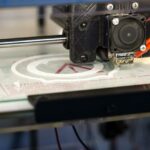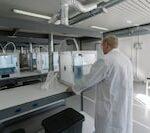 3D printing allows visually impaired parents to see their unborn babies. When parents are expecting a child, they often have many questions about what their baby will look like. Will they have my eyes? My nose? What color hair will they have?
3D printing allows visually impaired parents to see their unborn babies. When parents are expecting a child, they often have many questions about what their baby will look like. Will they have my eyes? My nose? What color hair will they have?

For parents who are blind or visually impaired, these questions can be even more challenging to answer without being able to see an ultrasound of their unborn child. For blind or visually impaired parents, questions about their unborn child’s appearance can be challenging to answer without seeing an ultrasound.
 Ultrasounds are a standard part of prenatal care, providing parents with their first glimpse of their developing baby. But for blind or visually impaired parents, questions about their unborn child’s appearance can be challenging without seeing the ultrasound image.
Ultrasounds are a standard part of prenatal care, providing parents with their first glimpse of their developing baby. But for blind or visually impaired parents, questions about their unborn child’s appearance can be challenging without seeing the ultrasound image.
3D Printing Creates 3D Fetus
That’s where 3D printing comes in . By creating a three-dimensional replica of the fetus, visually impaired parents can now “see” their unborn child and get a better sense of what they will look like when they’re born. Parents often wonder what features their children will inherit from them.
. By creating a three-dimensional replica of the fetus, visually impaired parents can now “see” their unborn child and get a better sense of what they will look like when they’re born. Parents often wonder what features their children will inherit from them.
3D printing has allowed visually impaired parents to see their unborn babies. Technology has been a life-changer for these parents, who often wonder what features their children will inherit from them.
 3D printing allows them to visualize their child and see what physical characteristics they may have inherited from either parent. This has brought a new level of excitement and joy for these families as they await the arrival of their bundle of joy. Will they have my eyes? My nose? What color hair will they have?
3D printing allows them to visualize their child and see what physical characteristics they may have inherited from either parent. This has brought a new level of excitement and joy for these families as they await the arrival of their bundle of joy. Will they have my eyes? My nose? What color hair will they have?
3D printing has revolutionized the medical field

In many ways, one of the most impressive applications is its ability to allow visually impaired parents to “see” their unborn babies. Using unique algorithms, 3D printers can create a realistic model of the baby based on ultrasound data.
It gives parents a chance to see what their child will look like and even get an idea of what features they may have inherited from mom and dad. This technology is truly a godsend for parents waiting anxiously to discover what their child will look like. Expectant parents who are blind or have low vision can now use advanced 3D printing technology to “see” their unborn babies. This new technique, created by researchers at the University of Minnesota, is the first of its kind and could revolutionize how parents with visual impairments experience pregnancy.
Here’s how it works:
A 3D-printed cast is created of the expectant mother’s abdomen. Doctors then use specialized 3D scanners to capture hundreds of measurements of the shape of the fetus.
A computer algorithm interprets the measurements to create a 3D computer rendering of the unborn child. A particular printer then deposits liquid resin in thin layers to create the 3D-printed renderings of the baby’s face and body. What we do know is that the baby was born without complications.
 When expectant parent contacts their ophthalmologist to schedule an ultrasound, they request a high-resolution, 3D model of their baby. The ophthalmologist sends the file to the University of Minnesota, where engineers print a model using a 3D printer.
When expectant parent contacts their ophthalmologist to schedule an ultrasound, they request a high-resolution, 3D model of their baby. The ophthalmologist sends the file to the University of Minnesota, where engineers print a model using a 3D printer.
The parent then receives the figurine through the mail. “We use the same type of material they use in designing cars and bridges,” says Richard Ohrns, professor of mechanical engineering.
The researchers use facial recognition software, a CT scan, and high-tech printing to create a 3D model of the fetus. It can then be printed in 3D and colored by hand on a 3D printer. When the model is held in hand or placed on the belly, it gives blind parents the experience of “seeing” their unborn baby.
 High-resolution volumetric ultrasound images are captured using a conventional fetal ultrasound machine and printed in 3D using a 3D printer. These 3D-printed objects serve as a proxy for what the parents cannot see and allow for enhanced communication during the pregnancy.
High-resolution volumetric ultrasound images are captured using a conventional fetal ultrasound machine and printed in 3D using a 3D printer. These 3D-printed objects serve as a proxy for what the parents cannot see and allow for enhanced communication during the pregnancy.
The 3D printing method
Uses ultrasound data converted into 3D volume images. Parents can then touch the pictures, which have been printed on a 3D bio-ink printer, to get a feel for their unborn baby. The process is quite simple and only takes minutes to complete. The researchers use a computer algorithm to turn the 3D volume data into 3D surface data.
Can You Help?
We don’t want to offend you, but we’re reaching out and asking for your help in leaving us a comment. It’s easy to do and only takes a few minutes. We would love to know what you think. We appreciate your feedback. We only ask for comments and reviews from our community to improve our services.
Don’t you agree that reading reviews of a business’s services or products helps you make an informed decision?
Thanks for being part of the community!
Bullwinkle
